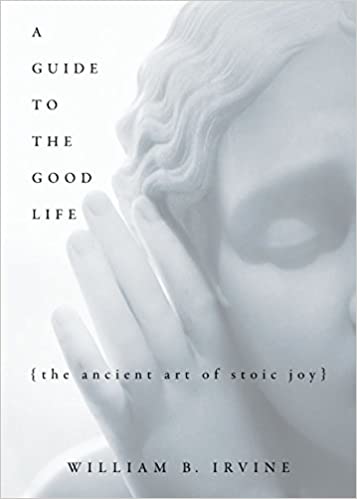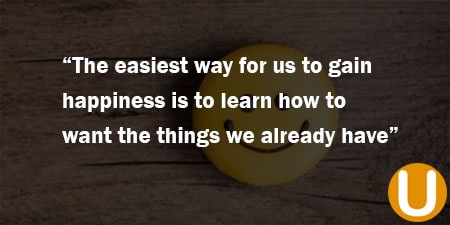A Guide to the Good Life Summary
- Book by William Irvine
The Book in 1 Sentences
A Guide to the Good Life: The Ancient Art of Stoic Joy
William B. Irvine says: “I wrote this book with the following question in mind: If the ancient Stoics had taken it upon themselves to write a guidebook for twenty-first-century individuals—a book that would tell us how to have a good life—what might that book have looked like? The pages that follow are my answer to this question.”
5 BIG Ideas
1. If you lack a grand goal in living, you lack a coherent philosophy of life.
2. “The easiest way for us to gain happiness is to learn how to want the things we already have.”
3. “We should live as if this very moment were our last.”
4. “After expressing his appreciation that his glass is half full rather than being completely empty, [a Stoic] will go on to express his delight in even having a glass: It could, after all, have been broken or stolen.”
5. “Our most important choice in life, according to Epictetus, is whether to concern ourselves with things external to us or things internal.”
A Guide to the Good Life Summary
The Primary Goals of life
1. The Art of Living
“According to Epictetus, the primary concern of philosophy should be the art of living: Just as wood is the medium of the carpenter and bronze is the medium of the sculptor, your life is the medium on which you practice the art of living.”
Buddha also says: “As irrigators lead water where they want, as archers make their arrows straight, as carpenters carve wood, the wise shape their minds.”
Living is an art that anyone wants to live a good life must practice. It’s an art to control your mind, your feelings, your responses and how to perceive the world.
This is hard at the beginning, but really worth it.
So, let’s dive right into some of the greatest Stoic principles for living a good life.
2. Stoic Virtue (to Have a Purpose)
“For the Stoics, a person’s virtue does not depend, for example, on her sexual history. Instead, it depends on her excellence as a human being—on how well she performs the function for which humans were designed.”
“To be virtuous, then, is to live as we were designed to live; it is to live, as Zeno put it, in accordance with nature. The Stoics would add that if we do this, we will have a good life.”
As Aurelius also says in Meditations: “Everything - a horse, a vine - is created for some duty... For what task, then, were you yourself created? A man’s true delight is to do the things he was made for.”
Again, to be virtuous is to live for a purpose. Everyone is designed for something to do - a purpose- It’s your goal to find your biggest WHY and work on it.
How to Deal with Life
1. Hedonic Adaptation!
What is Hedonic Adaptation?
“We humans are unhappy in large part because we are insatiable; after working hard to get what we want, we routinely lose interest in the object of our desire. Rather than feeling satisfied, we feel a bit bored, and in response to this boredom, we go on to form new, even grander desires.”
“The psychologists Shane Frederick and George Loewenstein have studied this phenomenon and given it a name: hedonic adaptation. To illustrate the adaptation process, they point to studies of lottery winners.
Winning a lottery typically allows someone to live the life of his dreams.
It turns out, though, that after an initial period of exhilaration, lottery winners end up about as happy as they previously were. They start taking their new Ferrari and mansion for granted, the way they previously took their rusted-out pickup and cramped apartment for granted.”
“Hedonic adaptation has the power to extinguish our enjoyment of the world. Because of adaptation, we take our life and what we have for granted rather than delighting in them.”
“Throughout the millennia and across cultures, those who have thought carefully about desire have drawn the conclusion that spending our days working to get whatever it is we find ourselves wanting is unlikely to bring us either happiness or tranquility.”
Think about that, I’m sure that you experienced hedonic adaptation before. I always felt that kind of boredom after getting what I desperately wanted! That’s weird!
So, how can we deal with Hedonic Adaptation?
“One key to happiness is to forestall the [hedonic] adaptation process: We need to take steps to prevent ourselves from taking for granted, once we get them, the things we worked so hard to get.”
“The easiest way for us to gain happiness is to learn how to want the things we already have.”
Further explanation: “After expressing his appreciation that his glass is half full rather than being completely empty, [a Stoic] will go on to express his delight in even having a glass: It could, after all, have been broken or stolen.”
And that takes us to a Stoic exercise that will make you appreciate what you already got. It’s called “Negative visualization”.
2. Negative Visualization
What is Negative Visualization?
“The Stoics thought they had an answer to this question. They recommended that we spend time imagining that we have lost the things we value—that our wife has left us, our car was stolen, or we lost our job. Doing this, the Stoics thought, will make us value our wife, our car, and our job more than we otherwise would.
This technique—let us refer to it as negative visualization—was employed by the Stoics at least as far back as Chrysippus. It is, I think, the single most valuable technique in the Stoics’ psychological tool kit.”
Negative visualization is a powerful antidote to hedonic adaptation. By consciously thinking about the loss of what we have, we can regain our appreciation of it, and with this regained appreciation we can revitalize our capacity for joy.
“The Stoics primary grief-prevention strategy was to engage in negative visualization.”
“Negative visualization teaches us to embrace whatever life we happen to be living and to extract every bit of delight we can from it. But it simultaneously teaches us to prepare ourselves for changes that will deprive us of the things that delight us. It teaches us, in other words, to enjoy what we have without clinging to it.”
A few times each day or a few times each week a Stoic will pause in his enjoyment of life to think about how all this, all these things he enjoys, could be taken from him.
What if you never had what you have right now?!
“In normal, prospective negative visualization, we imagine losing something we currently possess; in retrospective negative visualization, we imagine never having had something that we have lost.”
Think about that and take your time. Everything you have at this very moment is a blessing that you worked hard for days, months or even years to get.
Appreciate that…
“Epictetus also offers advice on grief management. He advises us, in particular, to take care not to “catch” the grief of others.”
Negative visualization is a really powerful tool to appreciate what you got, that takes us to another stoic tool that will help you even more in controlling your emotions. It is “Projective Visualization”
3. Projective Visualization
“The negative visualization technique, by the way, can also be used in reverse: Besides imagining that the bad things that happened to others happen to us, we can imagine that the bad things that happen to us happened instead to others.
In his Handbook, Epictetus advocates this sort of “projective visualization.” Suppose, he says, that our servant breaks a cup. We are likely to get angry and have our tranquility disrupted by the incident.
One way to avert this anger is to think about how we would feel if the incident had happened to someone else instead. If we were at someone’s house and his servant broke a cup, we would be unlikely to get angry; indeed, we might try to calm our host by saying “It’s just a cup; these things happen.”
Engaging in projective visualization, Epictetus believes, will make us appreciate the relative insignificance of the bad things that happen to us and will therefore prevent them from disrupting our tranquility.”
So, when something “bad” happens to you:
Take a deep breath.
Imagine what would you feel and act if the same thing happened to someone else, what would you say to him/her? Are you going to be angry and frustrated?
I think you got the answer..
This technique is really powerful in attaining your calmness and tranquility.
By the way, tranquility is a state marked by the absence of negative emotions such as anger, grief, anxiety, and fear, and the presence of positive emotions—in particular, joy.
And that takes us to another powerful principle.. We are living in a dream world!
4. Living in a Dream World
“Alternatively, we can do some historical research to see how our ancestors lived. We will quickly discover that we are living in what to them would have been a dream world—that we tend to take for granted things that our ancestors had to live without, including antibiotics, air conditioning, toilet paper (!), cell phones, television, windows, eyeglasses, and fresh fruit in January.
Upon coming to this realization, we can breathe a sigh of relief that we aren’t our ancestors, the way our descendants will presumably someday breathe a sigh of relief that they aren’t us!”
How we live right now is a dream for our ancestors. We are living in a magical world, we got all we need, just think about that. as Louis CK tells us “Everything’s amazing and nobody’s happy.” Watch his video.. It's hilarious 😀
So, how could we live our lives to the fullest? We are living in a DREAM WORLD!
That takes us to another Stoic technique for living..
5. Impermanence, Flux and Change
“I mentioned in the introduction that some of the things that attracted me to Buddhism could also be found in Stoicism. Like Buddhists, Stoics advise us to contemplate the world’s impermanence.
“All things human,” Seneca reminds us, “are short-lived and perishable.” Marcus likewise reminds us that the things we treasure are like the leaves on a tree, ready to drop when a breeze blow.
He also argues that the “flux and change” of the world around us are not an accident but an essential part of our universe.”
Just remember to live everyday like it’s your last day, one day you will be right.
“By contemplating the impermanence of everything in the world, we are forced to recognize that every time we do something could be the last time we do it, and this recognition can invest the things we do with a significance and intensity that would otherwise be absent.”
And also remember that “We should love all of our dear ones …, but always with the thought that we have no promise that we may keep them forever—nay, no promise even that we may keep them for long.”—Seneca
6. How to Be TRULY Alive
Again, as it’s important: “We should live as if this very moment were our last.”
Then “We will no longer sleepwalk through our life. Some people, I realize, will find it depressing or even morbid to contemplate impermanence. I am nevertheless convinced that the only way we can be truly alive is if we make it our business periodically to entertain such thoughts.”
Take care “When the Stoics counsel us to live each day as if it were our last, their goal is not to change our activities but to change our state of mind as we carry out those activities.”
It’s not about feeling that you are a living dead! It’s about living every single moment with passion. Got it?
7. Our Most Important Choice
“Our most important choice in life, according to Epictetus, is whether to concern ourselves with things external to us or things internal.
Most people choose the former because they think harms and benefits come from outside themselves.
According to Epictetus, though, a philosopher—by which he means someone who has an understanding of Stoic philosophy—will do just the opposite. He will look “for all benefit and harm to come from himself.” In particular, he will give up the rewards the external world has to offer in order to gain “tranquility, freedom, and calm.””
So, “While most people seek to gain contentment by changing the world around them, Epictetus advises us to gain contentment by changing ourselves—more precisely, by changing our desires.”
“There are things over which we have complete control, things over which we have no control at all, and things over which we have some but not complete control.”
“We must learn to welcome whatever falls to our lot and persuade ourselves that whatever happens to us is for the best.”

GET Blinkist 7 Days FREE Trial
3000+ Book Summaries
(Audio and Text)
The world is inside-out, control your mind, respond to the things you have control on wisely and try to ignore what you can’t control.
Marcus Aurelius says: “Begin each day by telling yourself: Today I shall be meeting with interference, ingratitude, insolence, disloyalty, ill-will, and selfishness—all of them due to the offenders’ ignorance of what is good or evil.”
Just prepare yourself and take it easy!
Check out this exercise: “To help us advance our practice of Stoicism, Seneca advises that we periodically meditate on the events of daily living, how we responded to these events, and how, in accordance with Stoic principles, we should have responded to them.”
How to Respond to Insults
1. Sting-Elimination Strategies
“One of their sting-elimination strategies is to pause, when insulted, to consider whether what the insulter said is true.”
“Another sting-elimination strategy, suggested by Epictetus, is to pause to consider how well-informed the insulter is.”
“One particularly powerful sting-elimination strategy is to consider the source of an insult.”
“One other important sting-elimination strategy, say the Stoics, is to keep in mind, when insulted, that we ourselves are the source of any sting that accompanies the insult.”
“Under such circumstances, rather than feeling hurt by his insults, I should feel relieved: If he disapproves of what I am doing, then what I am doing is doubtless the right thing to do.”
Remember this example: “When a dog barks, we might make a mental note that the dog in question appears to dislike us, but we would be utter fools to allow ourselves to become upset by this fact, to go through the rest of the day thinking, ‘Oh, dear! That dog doesn’t like me!’”
“Remember,” says Epictetus, “that what is insulting is not the person who abuses you or hits you, but the judgment about them that they are insulting.”
“When we find ourselves irritated by someone’s shortcomings, we should pause to reflect on our own shortcomings. Doing this will help us become more empathetic to this individual’s faults and therefore become more tolerant of him.”
“When dealing with an annoying person, it also helps to keep in mind that our annoyance at what he does will almost invariably be more detrimental to us than whatever it is he is doing.”
“Marcus recommends that when we interact with an annoying person, we keep in mind that there are doubtless people who find us to be annoying.”
2. Stoic Ways to Respond to Insults
“Epictetus advises you to respond not by behaving defensively but by questioning his competence as an insulter; for example, you can comment that if the insulter knew you well enough to criticize you competently, he wouldn’t have pointed to the particular failings that he did but would instead have mentioned other, much worse failings.”
The Stoics advocated a second way to respond to insults: with no response at all.
“Refusing to respond to an insult is, paradoxically, one of the most effective responses possible.”
“Notice, too, that by not responding to an insulter, we are showing him and anyone who is watching that we simply don’t have time for the childish behavior of this person.”
“The best way to deal with insults directed at the disadvantaged, Epictetus would argue, is not to punish those who insult them but to teach members of disadvantaged groups techniques of insult self-defense.”
Remember this example: “If in the course of trying to train a horse, we punish him, it should be because we want him to obey us in the future, not because we are angry about his failure to obey us in the past.”
More Stoic Wisdom
“When angry, says Seneca, we should take steps to ‘turn all [anger’s] indications into their opposites.’ We should force ourselves to relax our face, soften our voice, and slow our pace of walking. If we do this, our internal state will soon come to resemble our external state, and our anger, says Seneca, will have dissipated.”
“If we wish to retain our freedom, says Epictetus, we must be careful, while dealing with other people, to be indifferent to what they think of us.”
“Marcus agrees with Epictetus that it is foolish for us to worry about what other people think of us and particularly foolish for us to seek the approval of people whose values we reject.”
“A good Stoic, Marcus says, will not think about what other people are thinking except when he must do so in order to serve the public interest.”
“The Stoics recommend that we prepare for our dealings with other people before we have to deal with them.”
“When contemplating whether to criticize someone, he should consider not only whether the criticism is valid but also whether the person can stand to be criticized.”
“If you are going to publish, you must be willing to tolerate criticism.”
“We sometimes should think about the past to learn lessons that can help us in our efforts to shape the future.”
“Instead of thinking about how our situation could be worse, we refuse to think about how it could be better.”
“Besides contemplating bad things happening, we should sometimes live as if they had happened.”
“Spend time with an unclean person, and we will become unclean as well.”
“Your primary desire, says Epictetus, should be your desire not to be frustrated by forming desires you won’t be able to fulfill.”
That was my A Guide to the Good Life summary, a very quick look at this great book. If you haven’t read it yet and you’re interested in it, get a copy. There is a HUGE amount of wisdom and value in this book, and we’ve only touched on a tiny bit of it.
Buy The Book: A Guide to the Good Life by William Irvine

GET Blinkist 7 Days FREE Trial
3000+ Book Summaries
(Audio and Text)






